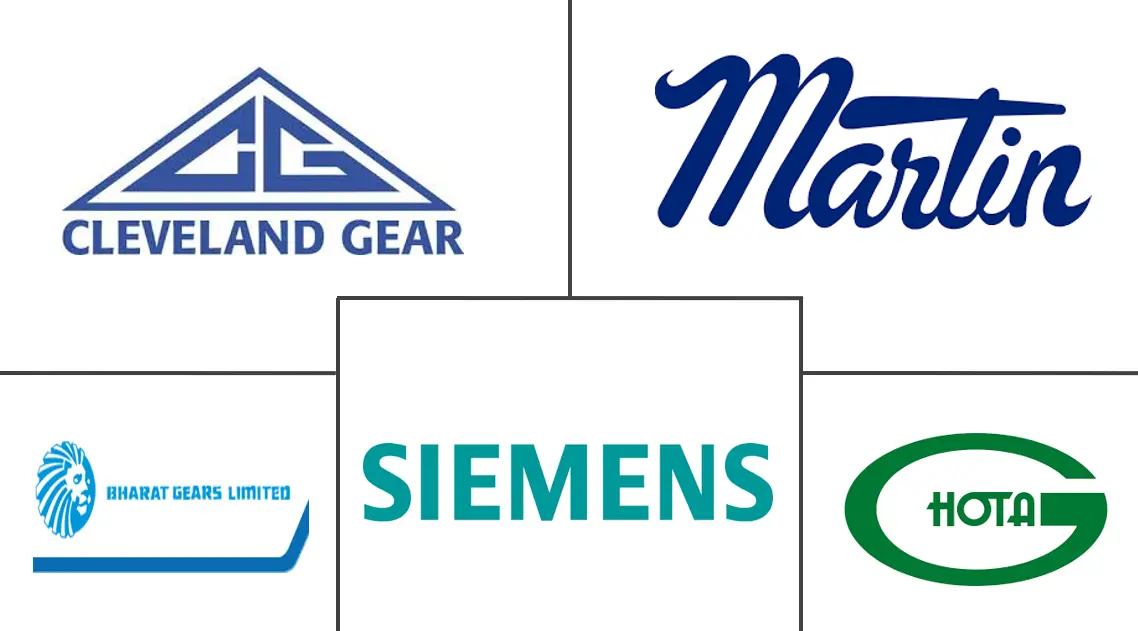Global Gear Market Size and Share
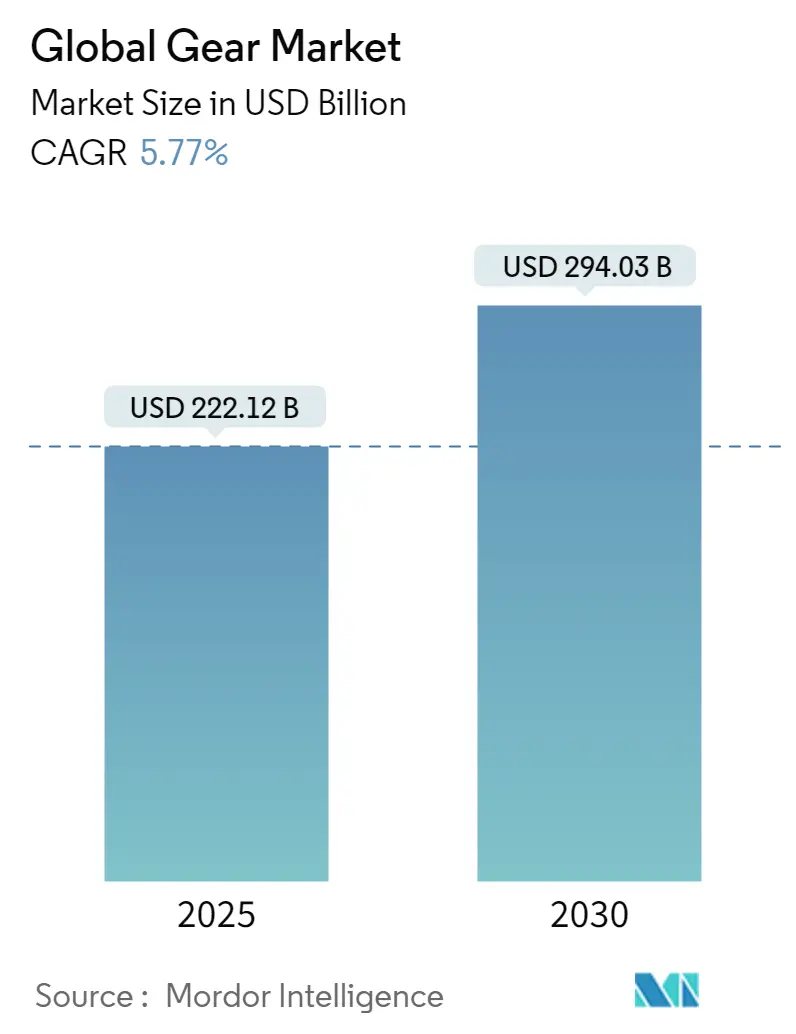
Global Gear Market Analysis by Mordor Intelligence
The Global Gear Market size is estimated at USD 222.12 billion in 2025, and is expected to reach USD 294.03 billion by 2030, at a CAGR of 5.77% during the forecast period (2025-2030).
- Over the medium term, factors such as rising industrial automation and the growing global wind energy installation are expected to be among the most significant drivers for the global gear market during the forecast period.
- High production costs for gears are expected to threaten the global gear market during the forecast period.
- However, continued efforts are being made to manufacture customized gears to effectively meet the client’s demand. This factor is expected to create several opportunities for the market in the future.
- Asia-Pacific is expected to grow significantly and register the highest annual growth rate during the forecast period. This is due to the region's growing manufacturing industry and focus on wind energy installations.
Global Gear Market Trends and Insights
The Oilfield Equipment Segment to Witness Growth
- The oilfield equipment segment represents a significant portion of the global gear market, encompassing a wide range of applications across the entire oil and gas value chain. This segment utilizes gears in critical machinery such as drilling rigs, pumps, compressors, and other equipment essential for the exploration, extraction, processing, and transportation of oil and gas resources.
- The upstream segment, or the exploration and production (E&P) segment, is a significant consumer of gears in the oilfield equipment segment. Gears play a crucial role in various equipment such as drilling rigs, mud pumps, drawworks, and wellhead systems. The demand for gears in the upstream segment is primarily driven by global oil and gas prices, technological advancements in exploration techniques (e.g., seismic imaging and horizontal drilling), and the increasing focus on deepwater and ultra-deepwater exploration.
- Crude oil production has witnessed significant growth in recent years due to the rising demand for crude oil due to expanding economies in Asia-Pacific and Africa. Additionally, due to sanctions on Russia, oil production has increased to meet the rising demand.
- According to the Energy Institute Statistical Review of World Energy, crude oil production witnessed a significant growth of 2% between 2022 and 2023. Similarly, the average annual growth rate over the past decade has been more than 1.1%, indicating an increasing growth in crude oil. This growth drives the demand for equipment, which fuels the demand for gear in the industry.
- The midstream segment includes pipelines, trucking fleets, tanker ships, and storage facilities. Gears are essential in pumps, compressors, and other equipment used in this segment, particularly in pipeline operations and LNG processing plants. The primary driving factors for gear demand in the midstream segment include the expansion of pipeline infrastructure, increasing global trade of liquefied natural gas (LNG), and the need for more efficient transportation and storage solutions.
- For instance, in June 2024, India's State-owned Oil and Natural Gas Corporation (ONGC) and Indian Oil Corporation (IOC) inked a deal to establish a compact liquefied natural gas (LNG) facility adjacent to the Hatta gas field in Madhya Pradesh. The plant, leveraging advanced technology, is poised to churn out LNG, heralded as a greener substitute to conventional fossil fuels. This increased demand for LNG will drive growth in the gears market, as specialized gears are essential for operating and maintaining LNG plants. This development is expected to stimulate innovation and investment in gear manufacturing technologies.
- The downstream segment is another critical end user of gears in the oilfield equipment market. Gears are used in various equipment within refineries and processing plants, such as pumps, compressors, mixers, and conveyor systems. The driving factors for gear demand in the downstream segment include the increasing global demand for refined petroleum products, the need for more efficient and environmentally friendly refining processes, and the growth of the petrochemical industry.
- Therefore, as per the above points, the oil and gas equipment end-user industry is expected to grow during the forecast period.
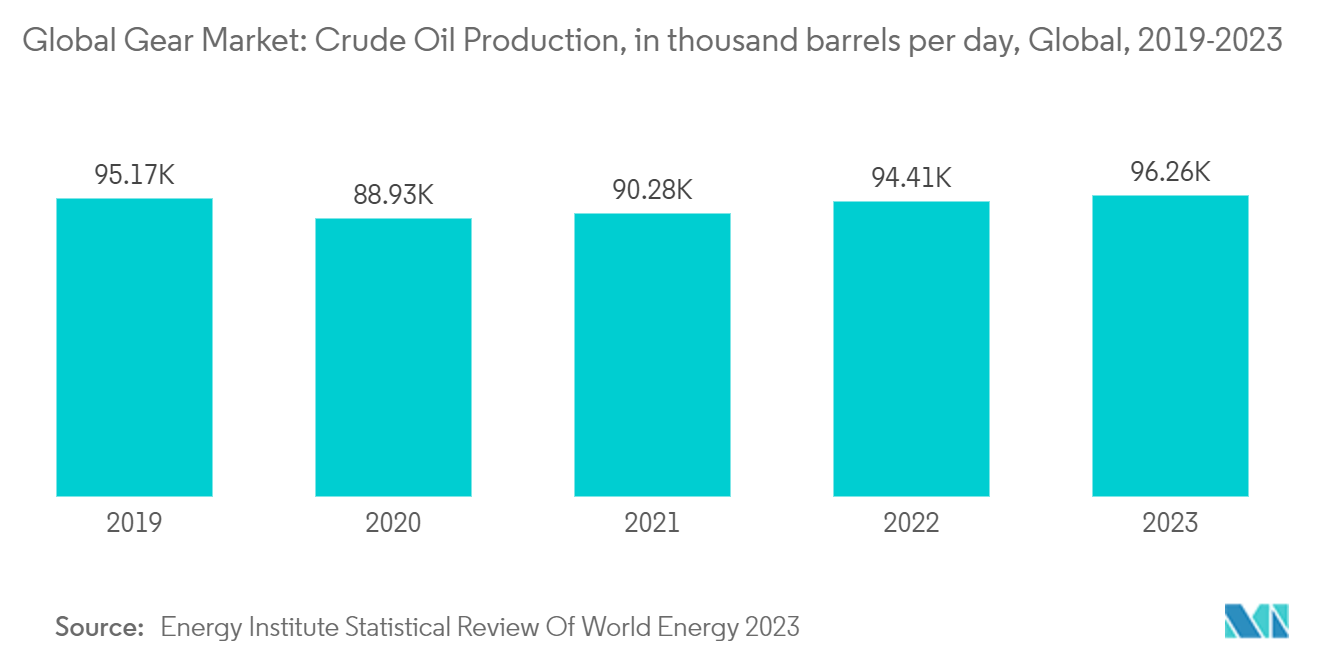
Asia-Pacific to Dominate the Market
- Asia-Pacific is a pivotal segment in the global gear market. With a burgeoning population and robustly growing economies, nations such as India, China, South Korea, and those in the ASEAN region are actively strengthening their industrial and manufacturing industries. This concerted effort creates a favorable market environment for the gears market.
- The automotive industry is one of the primary end users of gears in Asia-Pacific, with countries like Japan, South Korea, China, and India being major automotive manufacturing hubs. The segment's demand for gears spans a wide range, from transmission systems and differentials to steering mechanisms and engine components.
- According to the International Organization of Motor Vehicle Manufacturers, automobile manufacturing in Asia-Pacific significantly rose between 2022 and 2023. In 2023, the region manufactured 5,51,15,837 automobiles, resuming a 10% growth rate. The annual average growth rate between 2019 and 2023 was over 12%, signifying the rising demand for gears in the region.
- Similarly, the industrial segment is experiencing significant growth in the area, and the demand for gears is increasing with the expanding industrial segment. Gears are crucial in various applications, such as machine tools, material handling equipment, and heavy machinery used in construction and mining. The rapid industrialization across Asia-Pacific, particularly in countries like China, India, and Southeast Asia, has driven substantial demand for industrial gear.
- For instance, in the financial year 2023, India's manufacturing exports hit a record high, reaching USD 447.46 billion, marking a 6.03% growth from the previous year's (FY22) USD 422 billion. The manufacturing industry, contributing to 17% of India's GDP and employing over 27.3 million workers, is pivotal in the nation's economy. With various initiatives and policies, the Indian government aims to elevate manufacturing's market share to 25% by 2025.
- Additionally, the aerospace and defense industry represents another significant end user of gears in Asia-Pacific. Countries such as Japan, South Korea, China, and India are expanding their aerospace manufacturing capabilities. This expansion drives the demand for high-precision gears in aircraft engines, landing gear systems, and various control mechanisms.
- Therefore, as mentioned above, Asia-Pacific is expected to dominate the market during the forecast period.
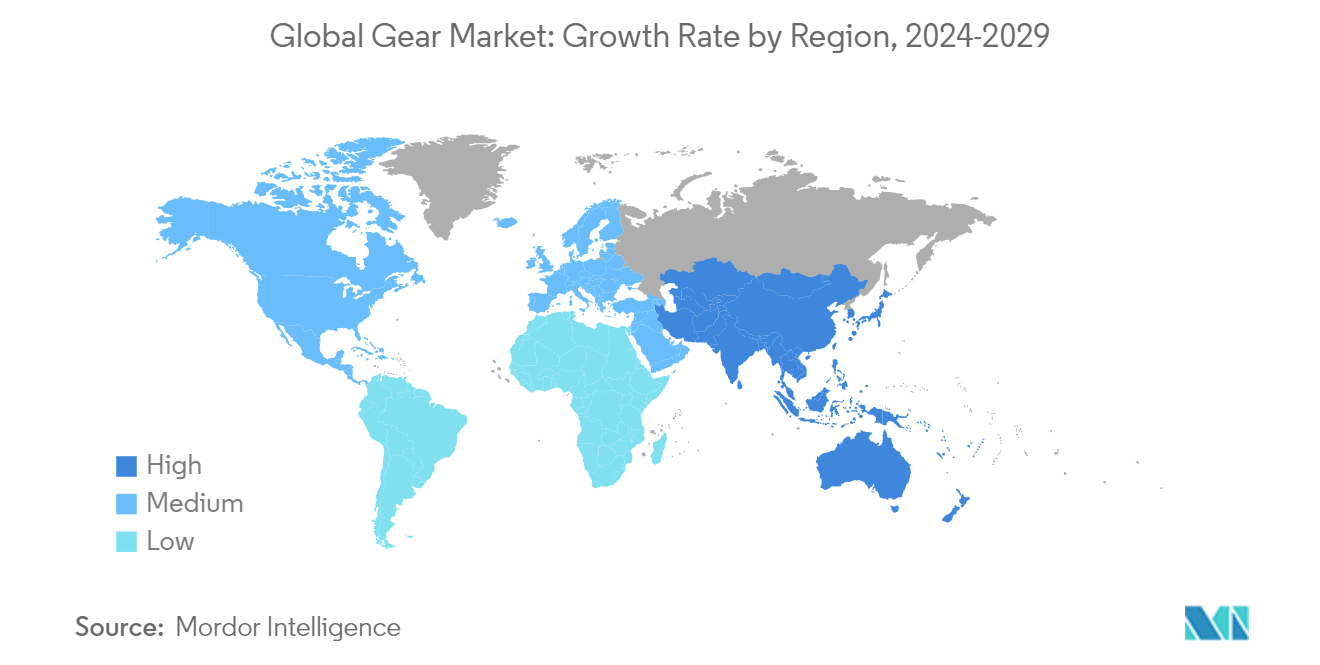
Competitive Landscape
The global gear market is fragmented. Some key players in this market (in no particular order) are Cleveland Gear Co., Siemens AG, Martin Sprocket & Gear Inc., Hota Industrial Mfg. Co. Ltd, and Bharat Gears Ltd.
Global Gear Industry Leaders
-
Siemens AG
-
Martin Sprocket & Gear, Inc
-
Hota Industrial Mfg. Co., Ltd.
-
Bharat Gears Ltd.
-
Cleveland Gear Co.
- *Disclaimer: Major Players sorted in no particular order
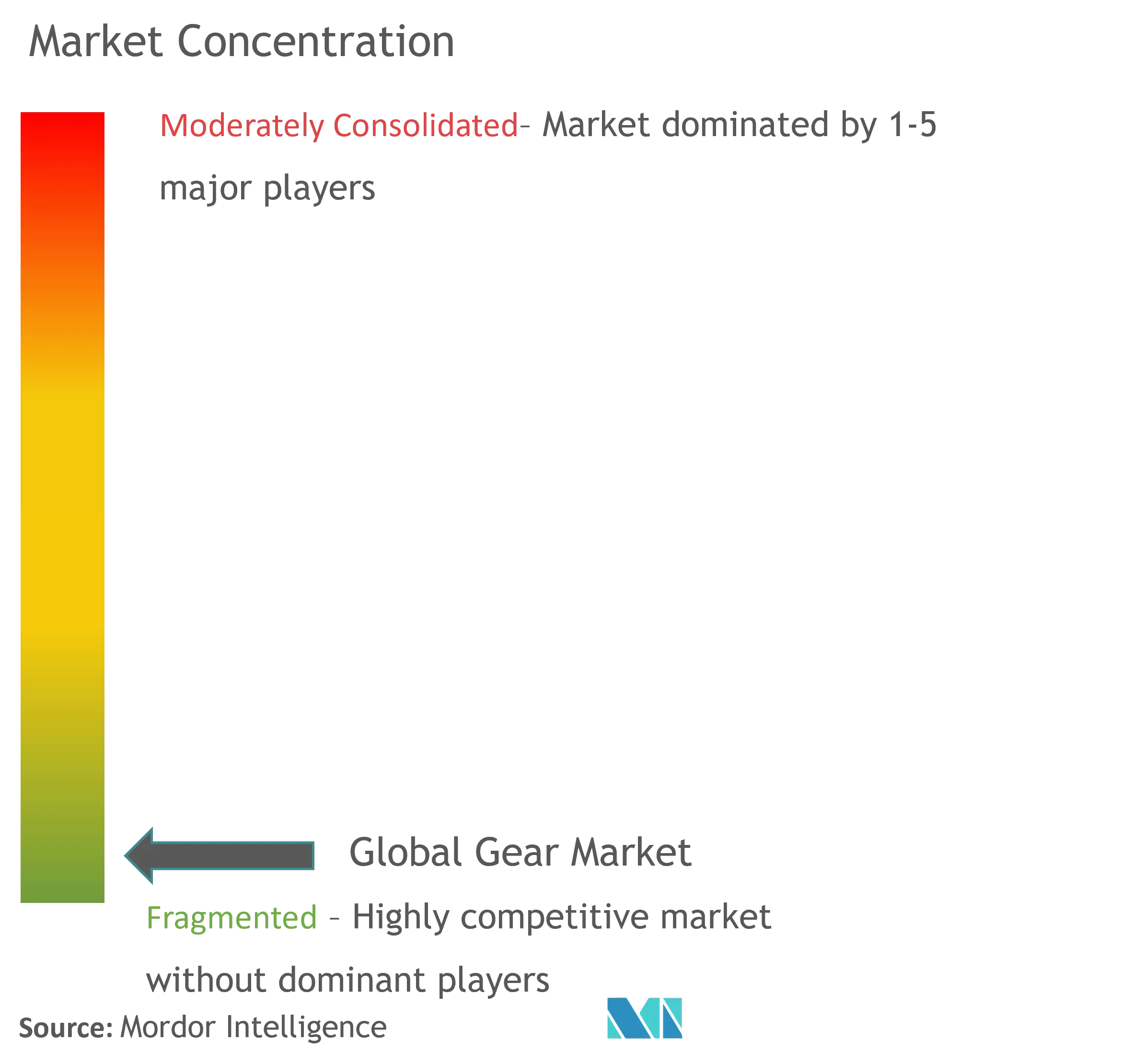
Recent Industry Developments
- April 2024: RS, a trading brand under the global provider of industrial solutions, RS Group PLC, introduced three new suppliers for mechanical power transmission solutions: Lenze, Bison Gear (AMETEK), and Dichtomatik. Bison Gear (AMETEK), a merger of AMETEK Dynamic Fluid Solutions and Bison Gear and Engineering Corporation, stands out as a premier global provider. They specialize in a range of mechanical power transmission products, from fluid-moving to fractional and integral horsepower AC and DC gear motors, along with parallel gearboxes.
- November 2023: Engineers from the University of Waterloo’s Faculty of Engineering unveiled ShapePro, a cutting-edge software designed to revolutionize gear-cutting processes. This innovative tool, developed to cater to the needs of large and medium-sized manufacturers, accurately predicts chip geometry and cutting mechanics for shaping, hobbing, and power skiving. ShapePro provides insights into machining forces and tool deflections and simplifies machining parameters' optimization, leading to time and cost savings.
Global Gear Market Report Scope
Gears are components with interlocking teeth that transmit torque and motion between rotating shafts. Gears are typically metal or plastic and come in various shapes and sizes. Gears are fundamental in machinery, from clocks and vehicles to industrial equipment, where they adjust speed, torque, and direction of movement. Their precision and durability make them essential in everyday devices and complex mechanical systems.
The global gear market is segmented by gear type, end-user industry, and geography (North America, Europe, Asia-Pacific, South America, and Middle East and Africa). By gear type, the market is segmented into spur gear, helical gear, planetary gear, rack and pinion gear, worm gear, bevel gear, and other gear types. By end-user industry, the market is segmented into oilfield equipment, mining equipment, industrial machinery, power plants, construction machinery, and other end-user industries. The report also covers the market sizes and forecasts for the gear market across major regions. Market sizing and forecasts are done for each segment based on revenue (USD).
| Spur Gear |
| Helical Gear |
| Planetary Gear |
| Rack and Pinion Gear |
| Worm Gear |
| Bevel Gear |
| Other Gear Types |
| Oilfield Equipment |
| Mining Equipment |
| Industrial Machinery |
| Power Plants |
| Construction Machinery |
| Other End-user Industries |
| North America | United States |
| Canada | |
| Rest of North America | |
| Europe | Germany |
| France | |
| United Kingdom | |
| Italy | |
| Spain | |
| NORDIC | |
| Russia | |
| Turkey | |
| Rest of Europe | |
| Asia-Pacific | China |
| India | |
| Australia | |
| Japan | |
| South Korea | |
| Malaysia | |
| Thailand | |
| Indonesia | |
| Vietnam | |
| Rest of Asia-Pacific | |
| Middle East and Africa | Saudi Arabia |
| United Arab Emirates | |
| Nigeria | |
| Egypt | |
| Qatar | |
| South Africa | |
| Rest of Middle East and Africa | |
| South America | Brazil |
| Argentina | |
| Colombia | |
| Rest of South America |
| Gear Type | Spur Gear | |
| Helical Gear | ||
| Planetary Gear | ||
| Rack and Pinion Gear | ||
| Worm Gear | ||
| Bevel Gear | ||
| Other Gear Types | ||
| End-user Industry | Oilfield Equipment | |
| Mining Equipment | ||
| Industrial Machinery | ||
| Power Plants | ||
| Construction Machinery | ||
| Other End-user Industries | ||
| Geography [Market Size and Demand Forecast till 2029 (for regions only)] | North America | United States |
| Canada | ||
| Rest of North America | ||
| Europe | Germany | |
| France | ||
| United Kingdom | ||
| Italy | ||
| Spain | ||
| NORDIC | ||
| Russia | ||
| Turkey | ||
| Rest of Europe | ||
| Asia-Pacific | China | |
| India | ||
| Australia | ||
| Japan | ||
| South Korea | ||
| Malaysia | ||
| Thailand | ||
| Indonesia | ||
| Vietnam | ||
| Rest of Asia-Pacific | ||
| Middle East and Africa | Saudi Arabia | |
| United Arab Emirates | ||
| Nigeria | ||
| Egypt | ||
| Qatar | ||
| South Africa | ||
| Rest of Middle East and Africa | ||
| South America | Brazil | |
| Argentina | ||
| Colombia | ||
| Rest of South America | ||
Key Questions Answered in the Report
How big is the Global Gear Market?
The Global Gear Market size is expected to reach USD 222.12 billion in 2025 and grow at a CAGR of 5.77% to reach USD 294.03 billion by 2030.
What is the current Global Gear Market size?
In 2025, the Global Gear Market size is expected to reach USD 222.12 billion.
Who are the key players in Global Gear Market?
Siemens AG, Martin Sprocket & Gear, Inc, Hota Industrial Mfg. Co., Ltd., Bharat Gears Ltd. and Cleveland Gear Co. are the major companies operating in the Global Gear Market.
Which is the fastest growing region in Global Gear Market?
Middle East and Africa is estimated to grow at the highest CAGR over the forecast period (2025-2030).
Which region has the biggest share in Global Gear Market?
In 2025, the Asia Pacific accounts for the largest market share in Global Gear Market.
What years does this Global Gear Market cover, and what was the market size in 2024?
In 2024, the Global Gear Market size was estimated at USD 209.30 billion. The report covers the Global Gear Market historical market size for years: 2019, 2020, 2021, 2022, 2023 and 2024. The report also forecasts the Global Gear Market size for years: 2025, 2026, 2027, 2028, 2029 and 2030.
Page last updated on:
Global Gear Market Report
Statistics for the 2025 Global Gear market share, size and revenue growth rate, created by Mordor Intelligence™ Industry Reports. Global Gear analysis includes a market forecast outlook for 2025 to 2030 and historical overview. Get a sample of this industry analysis as a free report PDF download.
